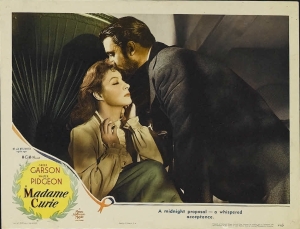
I personally don’t like Madame Curie, but it’s conducive in a grand classical sense; it feels wholesome so I cannot entirely dismiss it.
Overall, you will find Madame Curie to be a film of wholesomeness, scientific importance at the time, and some fine supporting performances, notwithstanding the attraction of Walter Pidgeon and Greer Garson together again, which may be not as effective as other times though.
A ‘Dynamic Duo’ From the 1940s
The classic film Madame Curie was another Greer Garson/Walter Pidgeon movie at the time. The leading couple put on several films together in the 1940s. This film puts the Garson/Pidgeon coupling to intended effect. They were a drawcard at the box office and were put in another kind of relationship and situation. However, Marie Curie’s discovery is not given a backseat in light of this. As student in Paris, Marie Sklodowska (Greer Garson) had potential and was paired with Pierre Curie (Walter Pidgeon) in his laboratory. Marie decides to head back to Poland, but Pierre embarks on wooing her. They marry and she takes her husband’s name and Marie stays put.
Story
In the film, Marie’s first hunch was the key to the discovery of radium. Yet the use of radium in products has since been banned as it causes cancer, which begs the question if her discovery was all it was cracked up to be. Yet the film uplifted the discovery and espoused faith in science and progress. If indeed the element had its worthwhile uses, then the discovery might have been beneficial in some areas. However, it was more than that as I will elaborate on below.
Legacy
As radium is now known as causing cancer, it might be that the film’s legacy is not a strong one. Yet, at the time, the discovery is regarded as important as it expanded scientific knowledge. The work involved in the discovery was an awesome work of intelligence and for a woman to achieve that at the time in a male dominated world was unthinkable to many.
Wholesome Film

One may say considering what we know now about the drawbacks of radium, that the film’s legacy is more like a wholesome kind of film, but though it is wholesome, it’s also an important work. A theme in the film is that science has the potential to escalate progress in society for the well-being of others, though one may question the use of radium in some ways now.
Qualities and Lack Thereof
The Greer Garson and Walter Pidgeon coupling found extraordinary success the year before with World War II propaganda, Mrs. Miniver. The Garson/Pidgeon combination worked the way intended as audiences did not complain, but in this they perfume the atmosphere with airs and graces that keep one at a distance. The final limit for me was wading through the lulls. I found the second half more interesting, as it gets into the scientific discovery process. Here, the pair are working overtime to isolate the element that would become radium.
Despite the demerits, the film is of a mild quality so is conducive to anyone who would watch. The love story is proper and in the traditional way and makes for something everyone can watch without someone being offended by watching an excessive romance.
For me it is in the supporting performances that one finds a human touch. Albert Basserman as Professor Jean Perot (in real life Count Jozef Wierusz-Kowalski), Dame May Whitty as Madame Eugene Curie, and Henry Travers as Eugene Curie, inject the spark of life.
Cast: Greer Garson, Walter Pidgeon, Henry Travers, Albert Bassermann, Robert Walker, C. Aubrey Smith, Dame May Whitty, Victor Francen, Elsa Bassermann, Reginald Owen, Van Johnson, Margaret O’Brien. Writers: Paul Osborn, Hans Rameau, Eve Curie. Director: George Marshall. Released December 16, 1943 (New York City), April 10, 1944 (UK).
Reviewed by Peter Veugelaers.